Michael J. Behe's Blog, page 77
May 2, 2022
Sabine Hossenfelder asks, did the W-boson break the Standard Model?
Hossenfelder is always good on these topics:
One thing that pops into your eye right away is that the mean value of the new measurement isn’t so different from earlier data analyses. The striking thing about this new analysis is the small error bar. That the error bar is so small is the reason why this result has such a high statistical significance. They quote a disagreement with the standard model at 6.9 sigma. That’s well above the discovery threshold in particle physics which is often somewhat arbitrarily put at 5 sigma.
What did they do to get the error bar so small? Well for one thing they have a lot of data. But they also did a lot of calibration cross-checks with other measurements, which basically means they know very precisely how to extract the physical parameters from the raw data, or at least they think they do. Is this reasonable? Yes. Is it correct? I don’t know. It could be. But in all honesty, I am very skeptical that this result will hold up. More likely, they have underestimated the error and their result is actually compatible with the other measurements.
But if it does hold up, what does it mean? It would mean that the standard model is wrong because there’d be a measurement that don’t fit together with the predictions of the theory. Then what? Well then we’d have to improve the standard model. Theoretical particle physicists have made many suggestions for how to do that, the most popular one has for a long time been supersymmetry. It’s also one of the possible explanations for the new anomaly that the authors of the paper discuss.
Sabine Hossenfelder, “Did the W-boson just “break the standard model”?” at BackRe(Action) (April 30, 2022)
The paper is open access.
Anyway, Rob Sheldon has the story here. Sheldon: What this paper and journo piece reveals is the desperation felt in the particle physics community. They so desperately need the Standard Model to fail.
Copyright © 2022 Uncommon Descent . This Feed is for personal non-commercial use only. If you are not reading this material in your news aggregator, the site you are looking at is guilty of copyright infringement UNLESS EXPLICIT PERMISSION OTHERWISE HAS BEEN GIVEN. Please contact legal@uncommondescent.com so we can take legal action immediately.Plugin by Taragana
The secret world in the gaps between brain cells
New York University neuroscientist Charles Nicholson explains:
It’s now known that every cell in the brain is separated from its neighbor by a fluid-filled extracellular space (ECS), which forms sheets and tunnels, as shown on page 26 in a computer reconstruction of the ECS in a rat’s brain. That interstitial fluid is predominantly an aqueous solution of sodium chloride with small concentrations of many other essential substances, such as potassium, calcium, and several amino acids and peptides. The ECS also hosts a sparse extracellular matrix of larger molecules. The space between cells is exceedingly narrow—much of it only tens of nanometers wide—and thus one of the most difficult domains of the brain to study in the living state. But without the ECS, electrical signals wouldn’t pass between neurons, metabolic substances and chemical signals wouldn’t disseminate, and drugs wouldn’t reach their targets. The long journey to finally observe and understand the ECS was made possible by innovations in the analysis of molecular diffusion.
Charles Nicholson, “The secret world in the gaps between brain cells” at Physics Today (May 26, 2022)
The paper is open access.
And it all just sorta happened. Didn’t that account work better when the brain was a grey mush?
Copyright © 2022 Uncommon Descent . This Feed is for personal non-commercial use only. If you are not reading this material in your news aggregator, the site you are looking at is guilty of copyright infringement UNLESS EXPLICIT PERMISSION OTHERWISE HAS BEEN GIVEN. Please contact legal@uncommondescent.com so we can take legal action immediately.Plugin by Taragana
May 1, 2022
At BigThink: Atheism not as rational as you think?
Something must be changing if points like this are being made at outfits like BigThink:
Most people who have ever lived believe in some sort of god; they are as certain of their gods as of their breath. But not a single organism outside our immediate evolutionary lineage has ever contemplated the existence of a god. Think about that for a moment: as far as we know, every single sentient being in the universe that has ever believed in a god is a member of our odd little species, and almost every member of our species has believed in a god. To scientists interested in evolution and human nature, religion is a puzzle that screams to be solved.
On closer inspection, religion is not an evolutionary puzzle so much as two evolutionary puzzles. First is the puzzle of faith: the puzzle of how Homo sapiens — and Homo sapiens alone — came to be a religious species. Second, there is the puzzle of atheism: how disbelief in gods can exist within an otherwise religious species. Will Gervais, “Atheism is not as rare or as rational as you think” at BigThink (April 15, 2022)
Hmmm. Can we start with: Is there any reason to believe that a cat, for example, can “believe in a god”? Creationism makes more sense all the time. If we are talking about human beings.
Copyright © 2022 Uncommon Descent . This Feed is for personal non-commercial use only. If you are not reading this material in your news aggregator, the site you are looking at is guilty of copyright infringement UNLESS EXPLICIT PERMISSION OTHERWISE HAS BEEN GIVEN. Please contact legal@uncommondescent.com so we can take legal action immediately.Plugin by Taragana
Claim: Complex cells started without oxygen
A way to bridge the gap:
Since the 1960s, many experts have argued that the emergence of eukaryotes (cells containing a clearly defined nucleus) happened in response to the oxygenation of Earth’s surface environment.
But a team led by the universities of Stanford and Exeter say recent advances in the Earth and life sciences challenge this view.
Their review says these breakthroughs “decouple” the emergence of eukaryotes (known as eukaryogenesis) from rising oxygen levels, and suggest eukaryotes in fact emerged in an anoxic (no-oxygen) environment in the ocean.
University of Exeter, “Origin of complex cells started without oxygen” at ScienceDaily (April 27, 2022)
Yes, the ham sandwich was invented that way too. It started without any ham…
The paper requires a fee or subscription.
Copyright © 2022 Uncommon Descent . This Feed is for personal non-commercial use only. If you are not reading this material in your news aggregator, the site you are looking at is guilty of copyright infringement UNLESS EXPLICIT PERMISSION OTHERWISE HAS BEEN GIVEN. Please contact legal@uncommondescent.com so we can take legal action immediately.Plugin by Taragana
Physicist Eric Hedin was bullied by atheists but not squashed
He said stuff he wasn’t allowed to say:
He emphasizes the limits to our physical universe — in time and material. There are limits to what random processes can do even in this massively large and old cosmos — the generation of life being the foremost boundary. As Hedin puts it, “nature cannot overcome the gargantuan information barrier between non-life and life.” Life with its “radiant beauty” defies naturalistic explanations.
David Klinghoffer, “Bullied by Atheists but Not Squashed, Physicist Eric Hedin Presents “Canceled Science”” at Evolution News and Science Today (April 28, 2022)
Eric Hedin is the author of Canceled Science: What some atheists don’t want you to see
Copyright © 2022 Uncommon Descent . This Feed is for personal non-commercial use only. If you are not reading this material in your news aggregator, the site you are looking at is guilty of copyright infringement UNLESS EXPLICIT PERMISSION OTHERWISE HAS BEEN GIVEN. Please contact legal@uncommondescent.com so we can take legal action immediately.Plugin by Taragana
FOR REFERENCE: Globular Cluster M55 as illustrating apparent aging of our galaxy (& cosmos)
It seems helpful to illustrate cosmological scale apparent aging as stars depart main sequence:
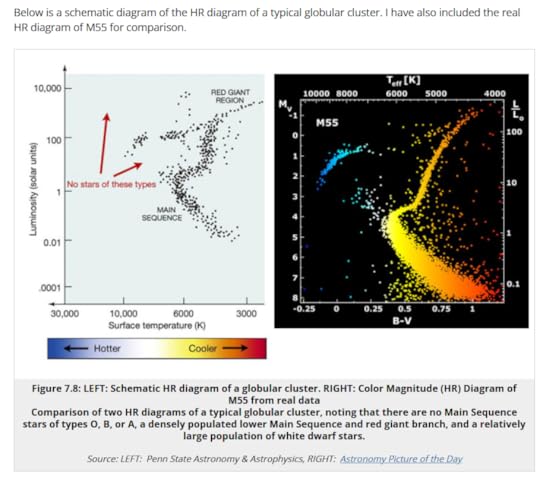
An idealised, Hertzsprung-Russell chart for Hydrogen-rich balls prone to become fusion furnaces is:
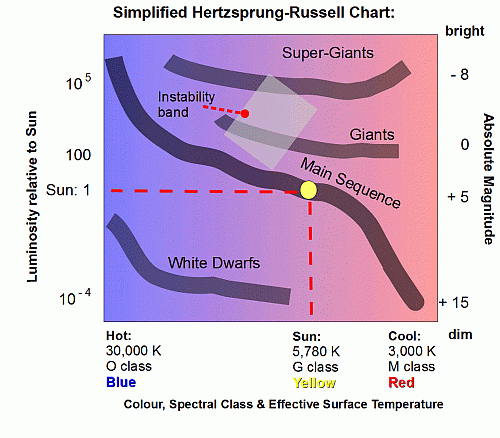
Here is a comparative plot (for open clusters), constructing a “clock” by projected pattern as a cluster ages, in effect seeing what is left as a candle burns down:
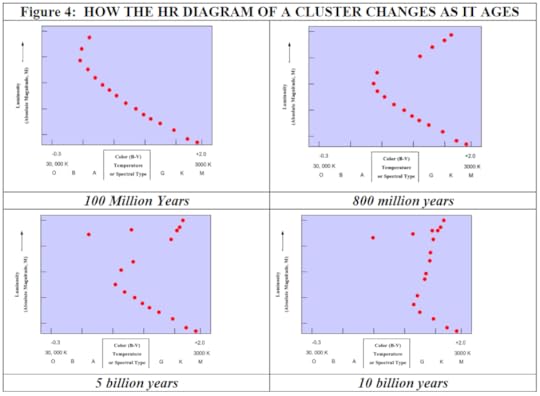
This can be taken as illustrative of how our cosmos shows entropy-associated aging on the grand scale.
Further illustrative, here is a NASA-derived cosmological timeline model, integrated with fine tuning:
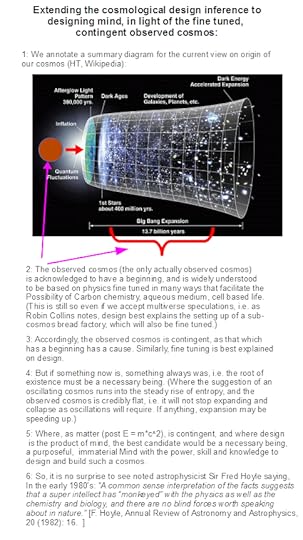
Speaking of fine tuning, Barnes et al summarise:
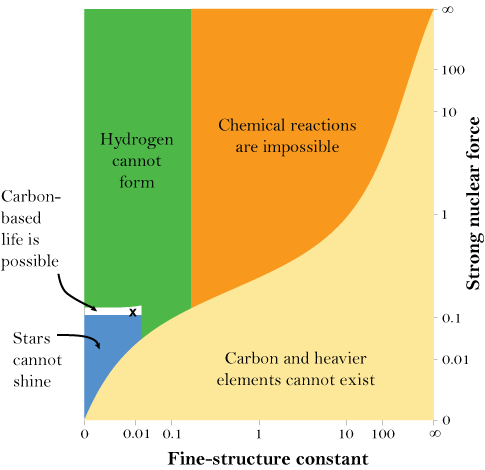 Barnes: “What if we tweaked just two of the fundamental constants? This figure shows what the universe would look like if the strength of the strong nuclear force (which holds atoms together) and the value of the fine-structure constant (which represents the strength of the electromagnetic force between elementary particles) were higher or lower than they are in this universe. The small, white sliver represents where life can use all the complexity of chemistry and the energy of stars. Within that region, the small “x” marks the spot where those constants are set in our own universe.” (HT: New Atlantis)
Barnes: “What if we tweaked just two of the fundamental constants? This figure shows what the universe would look like if the strength of the strong nuclear force (which holds atoms together) and the value of the fine-structure constant (which represents the strength of the electromagnetic force between elementary particles) were higher or lower than they are in this universe. The small, white sliver represents where life can use all the complexity of chemistry and the energy of stars. Within that region, the small “x” marks the spot where those constants are set in our own universe.” (HT: New Atlantis)All of this ties to core thermodynamics:

Food for thought. END
Copyright © 2022 Uncommon Descent . This Feed is for personal non-commercial use only. If you are not reading this material in your news aggregator, the site you are looking at is guilty of copyright infringement UNLESS EXPLICIT PERMISSION OTHERWISE HAS BEEN GIVEN. Please contact legal@uncommondescent.com so we can take legal action immediately.Plugin by Taragana
Globular Cluster M55 as illustrating apparent aging of our galaxy (& cosmos)
It seems helpful to illustrate cosmological scale apparent aging as stars depart main sequence:

An idealised, Hertzsprung-Russell chart for Hydrogen-rich balls prone to become fusion furnaces is:

Here is a comparative plot (for open clusters), constructing a “clock” by projected pattern as a cluster ages, in effect seeing what is left as a candle burns down:

This can be taken as illustrative of how our cosmos shows entropy-associated aging on the grand scale.
Further illustrative, here is a NASA-derived cosmological timeline model, integrated with fine tuning:

Speaking of fine tuning, Barnes et al summarise:
 Barnes: “What if we tweaked just two of the fundamental constants? This figure shows what the universe would look like if the strength of the strong nuclear force (which holds atoms together) and the value of the fine-structure constant (which represents the strength of the electromagnetic force between elementary particles) were higher or lower than they are in this universe. The small, white sliver represents where life can use all the complexity of chemistry and the energy of stars. Within that region, the small “x” marks the spot where those constants are set in our own universe.” (HT: New Atlantis)
Barnes: “What if we tweaked just two of the fundamental constants? This figure shows what the universe would look like if the strength of the strong nuclear force (which holds atoms together) and the value of the fine-structure constant (which represents the strength of the electromagnetic force between elementary particles) were higher or lower than they are in this universe. The small, white sliver represents where life can use all the complexity of chemistry and the energy of stars. Within that region, the small “x” marks the spot where those constants are set in our own universe.” (HT: New Atlantis)All of this ties to core thermodynamics:

Food for thought. END
Copyright © 2022 Uncommon Descent . This Feed is for personal non-commercial use only. If you are not reading this material in your news aggregator, the site you are looking at is guilty of copyright infringement UNLESS EXPLICIT PERMISSION OTHERWISE HAS BEEN GIVEN. Please contact legal@uncommondescent.com so we can take legal action immediately.Plugin by Taragana
New sleep molecule: Apparently, the machinery of sleep is very complex
According to the University of Copenhagen:
Previously, the scientists knew very little about the role played by miR-137 in the brain, but now Birgitte Kornum’s research team has demonstrated that it is associated with hypocretin regulation and thus with sleep.
“This is the first time a microRNA is associated with sleep regulation. Drawing on the UK Biobank, we discovered some genetic mutations in miR-137 which cause daytime sleepiness. The study demonstrates this connection in both mice and zebrafish, and we are able to prove the connection with hypocretin. Our discovery shows just how complex the machinery of sleep is. Imagine inheriting a variant of miR-137 that puts you at higher risk of feeling sleepy during the day,” says Birgitte Kornum.
University of Copenhagen, “New sleep molecule discovered: ‘It shows just how complex the machinery of sleep is’” at ScienceDaily (April 29, 2022)
The paper is open access.
Copyright © 2022 Uncommon Descent . This Feed is for personal non-commercial use only. If you are not reading this material in your news aggregator, the site you are looking at is guilty of copyright infringement UNLESS EXPLICIT PERMISSION OTHERWISE HAS BEEN GIVEN. Please contact legal@uncommondescent.com so we can take legal action immediately.Plugin by Taragana
April 29, 2022
At UnDark: Is risk aversion ruining science?
Stony Brook astrophysicist Paul Sutter argues the case:
I’ve encountered this problem myself. Years ago, after I completed my Ph.D. in physics, I began doing postdoctoral research studying cosmic voids, the vast regions of almost nothing that dominate the volume of the universe. A few collaborators and I were using voids to understand the evolution of the cosmos, and we were also fascinated by voids as objects themselves. However, as I was applying to jobs beyond that postdoc, I was told multiple times by senior (and well-meaning) scientists that I should focus on something else. Something more mainstream. Something safer. (Today, thanks to the dogged determination of my collaborators, cosmic void analysis is now a part of most major upcoming galaxy surveys.)
My experiences were not singular. I’ve met many junior scientists who were given similar advice, and senior scientists — now that I number among their ranks — confide that their top priority is in achieving deltas: a physics jargon word that they use here to refer to tiny, incremental advances of their current research. They quietly concede that the tenure system, designed to give academics the freedom to safely explore new directions, rarely serves that purpose.
Paul Sutter, “Risk Aversion Is Ruining Science” at UnDark (April 27, 2022)
You may also wish to read: Theoretical physicist on why she stopped working on black hole information loss. Hossenfelder: …. no one can tell which solution is correct in the sense that it actually describes nature, and physicists will not agree on one anyway. Because if they did, they’d have to stop writing papers about it.
Copyright © 2022 Uncommon Descent . This Feed is for personal non-commercial use only. If you are not reading this material in your news aggregator, the site you are looking at is guilty of copyright infringement UNLESS EXPLICIT PERMISSION OTHERWISE HAS BEEN GIVEN. Please contact legal@uncommondescent.com so we can take legal action immediately.Plugin by Taragana
Strong emergence principle emerges in biology
Things happen that can’t be explained without design:
Complex, multigenic biological traits are shaped by the emergent interaction of proteins being the main functional units at the molecular scale. Based on a phenomenological approach, algorithms for quantifying two different aspects of emergence were introduced (Wegner and Hao in Progr Biophys Mol Biol 161:54-61, 2021) describing: (i) pairwise reciprocal interactions of proteins mutually modifying their contribution to a complex trait (denoted as weak emergence), and (ii) formation of a new, complex trait by a set of n ‘constitutive’ proteins at concentrations exceeding individual threshold values (strong emergence). The latter algorithm is modified here to take account of protein redundancy with respect to a complex trait (‘full redundancy’). Irreducibility is considered a necessary and sufficient criterion for strong biological emergence; if one constitutive protein is missing, or its concentration drops below the threshold the trait is lost. A definition based on ‘unpredictability’ is dismissed, because this criterion is irrelevant for the evolution of a complex trait, and apparent unpredictability may rather reflect our basic deficits in understanding unless we can provide an unequivocal proof for it. The phenomenological approach advocated here allows to identify hidden rules according to which strongly emergent traits may be organized. This is of high value for understanding the evolution of complex traits which seems to require the saltational advent of all constitutive proteins ‘in one turn’ to arrive at a functional trait providing for an improved fitness of the organism. Rather than being a purely random process, it may be guided by fundamental structural principles.
Hao Z, Liu J, Wu B, Yu M, Wegner LH. Strong Emergence in Biological Systems: Is It Open to Mathematical Reasoning? Acta Biotheor. 2021 Dec;69(4):841-856. doi: 10.1007/s10441-021-09423-1. Epub 2021 Aug 31. PMID: 34463940.
Not that they put it that way.
The paper is open access.
Copyright © 2022 Uncommon Descent . This Feed is for personal non-commercial use only. If you are not reading this material in your news aggregator, the site you are looking at is guilty of copyright infringement UNLESS EXPLICIT PERMISSION OTHERWISE HAS BEEN GIVEN. Please contact legal@uncommondescent.com so we can take legal action immediately.Plugin by Taragana
Michael J. Behe's Blog
- Michael J. Behe's profile
- 219 followers



